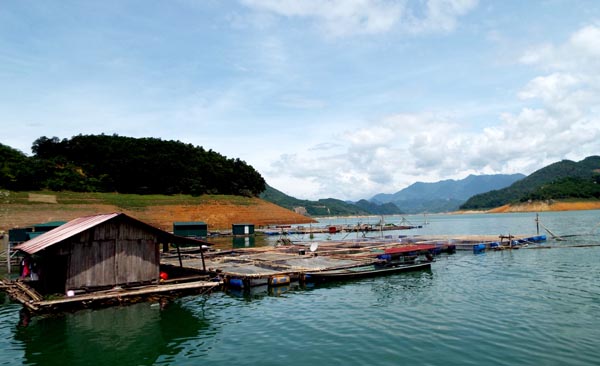
(HBO) – Hoa Binh Lake is the biggest artificial lake in Southeast Asia. Offering a wonderful view of nature and water dubbed as Ha Long Bay in land in Hoa Binh province, the lake has great potential for developing cultural, historical, eco-, and spiritual tourism serving tourists from Hanoi and neighbouring localities at weekends. As such, the lake is made the centre of tourism development in the province and region.
On August 1, 2016, the Prime Minister
issued Decision 1528/QD-TTg, approving the master plan of the national tourism
site at Hoa Binh Lake to 2030.
Accordingly, the site will cover 17
communes in Da Bac, Cao Phong, Tan Lac, Mai Chau districts and Hoa Binh city.
The central area spans about
1,200 hectare across Sung island – Thung Nai –
Ngoi Hoa.
In the plan, priorities are given to the
expansion of home-stay services in community-based tourism villages, the
development of high-end resorts in Sung island and Ngoi Hoa, hotels rated from
3 stars in Thai Binh and Thai Thinh, and floating resorts in Binh Thanh – Vay
Nua and Hien Luong.
The plans also looks to develop food
services, particularly traditional dishes of Muong people and other ethnic
minority groups in the region, with high-end restaurants earmarked for Ngoi
Hoa, Thung Nai, Thai Binh, Thai Thinh, Hien Luong, Binh Thanh, and Vay Nua.
Food streets and tourism-cultural markets are to be built along Da river bank
and in Hoa Binh city.

A view of Hoa Binh
lake from Tru hamlet in Thai Thinh commune (Hoa Binh city).
The master plan set targets of welcoming
around 630,000 tourist arrivals, of whom 30,000 are foreigners, in 2020, and
1.6 million tourists with about 90,000 foreigners by 2030. The province also
aims to earn about 200 billion VND from tourism by 2020 and 1.8 trillion VND by
2030.
To implement the Prime Minister-approved
master plan, relevant agencies are advising the provincial Party Committee in
drafting a thematic resolution on developing the Hoa Binh lake tourism site to
a national site. The resolution will set forth specific measures to achieve the
goal of developing the Hoa Binh lake tourism site to basically meet criteria of
a national tourism site by 2025.
The Hoa Binh lake national tourism site
will have a synchronous and modern infrastructure system by 2030, offering diverse
and high-quality tourist products. It
will become the province’s largest tourism centre, and one of the 12 key
national tourism sites of the northern mountainous and midland region. The
typical tourist products at the site will focus on the Muong ethnic culture and
the lake’s eco-system.
The province is requiring relevant
agencies to give their recommendations on building preferential policies and
mechanisms related to investment, land and land clearance, and finance and
credit incentives to mobilise all resources and attract competent businesses to
invest in the Hoa Binh lake. The province also gives priority to developing
electricity, transport, port and wharf infrastructure and supporting businesses
who invest in the lake tourism, using capital from its budget. In the short
term, it will call for investment to develop the central area of the lake in
the hope that it will later help attract more capital in the region.
Le Chung
With an increasingly vibrant and widespread emulation movement aimed at building cultured residential areas and cultured families, Yen Thuy District has been making steady progress toward improving both the material and spiritual well-being of its people, while fostering a civilized, prosperous, beautiful, and progressive community.
Once lacking recreational spaces and community facilities, Residential Group 2 in Quynh Lam Ward (Hoa Binh City) has recently received attention for the construction of a new, spacious, and fully equipped cultural house. The project followed the model of state support combined with public contributions in both labor and funding.
The "All people unite to build cultural life" movement, which has been effectively integrated with Kim Boi district’s socio-economic development goals, is fostering a lively spirit of emulation across local residential areas, hamlets, villages, public agencies, and enterprises. In addition, through the initiative, traditional cultural values are being preserved and promoted, while community solidarity and mutual support in poverty reduction and economic development are being strengthened.
A working delegation of the Hoa Binh provincial People’s Committee led by its Permanent Vice Chairman Nguyen Van Toan on June 11 inspected the progress of a project to build the Mo Muong Cultural Heritage Conservation Space linked to tourism services in Hop Phong commune, Cao Phong district.
Born and growing in the heroic land of Muong Dong, Dinh Thi Kieu Dung, a resident in Bo town of Kim Boi district, in her childhood was nurtured by the sweet lullabies of her grandmother and mother. These melodies deeply imprinted on her soul, becoming an inseparable part of her love for her ethnic group's culture. For over 20 years, this love for her hometown has driven Dung to research, collect, and pass down the cultural values of the Muong people to future generations.
In the final days of May, the Ethnic Art Troupe of Hoa Binh Province organized performances to serve the people in remote, mountainous, and particularly disadvantaged areas within the province. These were not just ordinary artistic shows, but they were the meaningful journeys aimed at spreading cultural values, enhancing the spiritual life of the people and contributing to the preservation of ethnic minority cultural identities.



